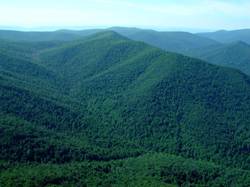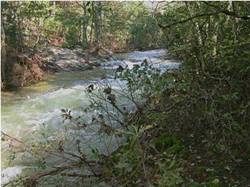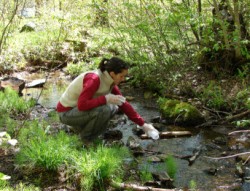Descriptions of Methods and Quality Assurance
Information about SWAS-VTSSS program analysis methods, including adjustments for instrument and methods changes, is provided in:
Descriptions of Water Quality Measurements
Acid neutralizing capacity (ANC): The ANC of surface water represents the effective balance between acids and bases in solution. ANC, measured by titration, also approximates the difference in the sums of base cations and strong-acid anions (see descriptions below) expressed in equivalent units. Other acids and bases (e.g., organic acids and aluminum ions) can also effect ANC. Surface water acidification, or loss of ANC, due to acidic deposition occurs when concentrations of strong-acid anions increase relative to concentrations of the base cations. If surface water ANC is reduced to sufficiently low values, acidity may increase, as indicated by a depression in pH, to a range associated with adverse effects on fish and other aquatic life. ANC in western Virginia mountain stream waters varies with watershed bedrock. ANC is reported in units of microequivalents per liter (µeq/L).
pH: A direct measure of acidity, expressed as the negative logarithm of hydrogen ion activity in equivalent units. The pH scale extends from 0 (most acidic) to 14 (most alkaline). A pH value of 7 is neutral. A difference of one pH unit indicates a tenfold increase in hydrogen activity. pH thresholds have been determined for aquatic species, including fish and benthic macroinvertebrates. The pH of western Virginia mountain stream waters is positively correlated with ANC and varies with watershed bedrock.
Specific conductance: A measure of electrical conductance in a solution. Conductivity in stream waters is closely related to the total concentration of dissolved ions. Differences in stream water conductivity indicate differences in ion concentration. Conductivity is also affected by temperature; specific conductance is conductivity normalized to 25°C. Specific conductance is reported in units of microSiemens per cm (µS/cm).
Base cations: Calcium, magnesium, potassium, and sodium ions. Base cations dissolved in western Virginia mountain stream waters are primarily derived from watershed bedrock and soil. Base cations in soil may buffer acidity by exchanging for acid anions. Loss of base cations from soil is a primary effect of acidic deposition. Base cation concentrations in western Virginia mountain stream waters vary with watershed bedrock. Base cation concentrations are reported in units of microequivalents per liter (µeq/L).
Strong-acid anions: Sulfate, nitrate, and chloride ions. Acid anions in western Virginia mountain stream waters are primarily derived from the atmosphere, deposited dissolved in precipitation or in particulate or gaseous form. Both sulfate and nitrate are derived from fossil fuel combustion and are associated with acidic deposition. Acidity associated with sulfate contributes to soil and water acidification in the region. Nitrogen, including nitrate and other nitrogen species, is a limiting nutrient in most Appalachian forests that usually does not contribute to watershed acidification. Acid anion concentrations are reported in units of microequivalents per liter (µeq/L).
Silica: A product of soil and bedrock weathering. Differences in stream water silica concentrations indicate differences in weathering rates and biogeochemical processes (e.g., diatom productivity). Silica concentrations are reported in units of micromoles/L (µmol/L).
In addition to the stream water constituents described above, the SWAS-VTSSS program routinely obtains additional analysis for a subset of samples, including aluminum ion, ammonium, and dissolved organic carbon. Results for these analyses are not reported here.




